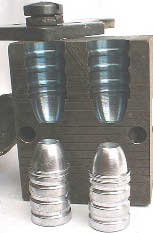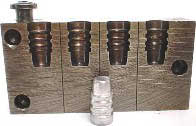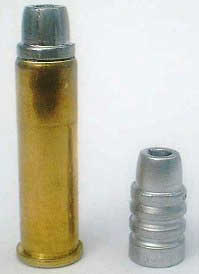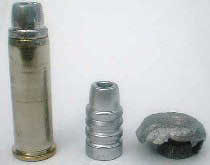|
Over the
years, I've had my share of feeling awkward. Not surprisingly, most of those
feelings came during my teenage years and involved girls. Anymore, awkwardness
is a thankfully rare sensation. But occasionally an awkward situation can
transform into something special. Recently a friend of mine had bid on an online
auction involving an unusual bullet mould that I was interested in. I casually
asked him to let me know if the bidding got too high for his comfort, and to let
me know if he was going to drop out, so that I could start bidding, as I did not
want to bid against my friend. This auction was for an Ideal 358446 HP mould,
one that I have been looking for for several years. My fondness for cast HP
bullets is no secret, and this particular mould occupies a unique spot in the
rich history of the .357 Magnum. I had all of the other significant .357 HP
moulds and was interested in adding this one to complete the story. In the end,
John ended up winning the auction. He then turned around and gave me the mould
as a gift. This made me feel a little awkward, as it made me feel as though I
had inadvertently shystered the mould out from under my friend. But the bottom
line is he steadfastly refused to let me pay him for the mould, and insisted
that I accept it as personal gift (so I sent him some bullets cast from it, as a
thank you gesture). Yes, John is a gracious man.
Back in the late 1920's Elmer Keith was exploring the use of high-pressure loads
in the S&W N-frame .38 Special, the Heavy Duty and the Outdoorsman. Given the
thick cylinder walls of these revolvers, he was able to safely work with much
higher pressures than were the norm in those days, and consequently, obtain much
higher velocities. At first he was using 12.0 grains DuPont #80 powder and
getting about 1100 fps with his 173 grain SWC (the Ideal 358429). Later, in 1933
when 2400 was introduced, he switched over to this powder and raised velocities
to 1200 fps. His fondness for 2400 would last for the rest of his life. S&W took
note of these experiments and decided to offer this new level of ballistics to
the shooters of the day. Working with Phil Sharpe, they developed a new
cartridge (made 1/10" longer so that it could not be loaded into smaller, weaker
guns) that operated at 35,000-40,000 psi peak pressure. Sharpe's load
development encompassed a wide variety of plain-based cast bullets, but focused
on the H&G #51 (the so-called "Sharpe solid", this was before the SWC term was
in common usage), a 160 grain SWC designed by Sharpe and inspired by Keith's
358429, and the 146 grain HP version of the H&G #51 (the "Sharpe HP"). Using
hefty doses of 2400, Sharpe was able to achieve velocities that were unheard of
for handguns (1500-1600 fps) with these bullets, along with excellent accuracy.
Thus, the .357 Magnum was born.
Keith's
358429 173 grain SWC is an excellent bullet, but it was designed for use in .38
Special cases in the .38/.44 Heavy Duty loads. Unfortunately, the nose turned
out to be too long to work in the longer .357 Magnum case (when chambered, the
nose would stick out past the front of the cylinder of the S&W Magnum and
prevent rotation). Sharpe had gone to George Hensley for his moulds, so when the
.357 Magnum was unveiled in 1935, Lyman/Ideal didn't have a bullet that was
really suitable for "The Magnum". Early reports talked about the leading
problems associated with factory ammo (which turned out to be due to marginal
lube quality), and so Lyman designed their .357 Magnum bullet to have an
unprecedented (for handguns) three lube grooves. If they were going to
stick with a "standard" bullet weight, this didn't leave much room for a crimp
groove, so they put in an itty-bitty one in the middle of the forward driving
band. The nose was made short enough to allow use in the new S&W Magnum, and the
bullet was named the Ideal 358443 (cataloged at the last minute in 1936).
 |
|
The Ideal 358443; the first bullet
Lyman designed for the .357 Magnum. |
|
With its
small meplat, deep seating, and wimpy crimp groove, the 358443 never was very
popular. Keith continued to promote his 358429 (either loaded into .38 Special
cases, or seated deeply into .357 brass and crimped over the forward driving
band). George Hensley teamed up with James Gibbs and started machining bullet
mould history, making high quality moulds, many for "The Magnum". Cramer and
Modern-Bond were also making well thought-out moulds for the .357 Magnum. Lyman,
the dominant bullet mould manufacturer in America, was losing the Magnum race.
Market
pressures clearly indicated that the American shooting public wanted a
flat-nosed SWC with a moderately large meplat, but with a nose that was short
enough to function in the S&W Magnum. So, Lyman responded by fattening up the
nose/ogive of the 358443 to something along the lines of the Sharpe solid,
converting the upper lube groove to a beveled crimp groove, moving the bottom
two lube grooves forward to create a thicker base band (to seal The Magnum's
high pressure gases more effectively) and eliminating that miniscule vestige of
a crimp groove. Thus was born the 358446, a 160 grain plain-based SWC, first
cataloged in 1940 and promoted as "the standard bullet for the .357 Magnum". It
was an excellent, and popular, bullet for the .357 Magnum cartridge for many
years.
|
 |
|
The Lyman 358446, "the standard bullet
for the .357 Magnum". |
|
It was
standard practice at the Lyman factory to offer, at the customer's request, any
non-HB mould design in HP form (sadly, this is no longer true). Some HP designs
(like the Keith 358439 and Gould 457122) were added to the catalog as standard
fare, others were offered on a special order basis. I have found no evidence in
the Ideal Handbooks of the period to indicate that the 358446 HP was ever listed
as a standard offering, however it does pop up from time to time in the gun
press of the times. For example, in the early 1960s Skeeter Skelton wrote of
using the 358446 HP in the .357 Magnum (his article was reprinted in "Hunting
for Handgunners" by Larry Kelly and JD Jones). He described how the HP cavity
was larger in the 358446 HP than it was in the similar gas-checked 358156 HP
(.150" vs. .125"), and the result was that the PB bullet opened up faster than
did the GC bullet.
My appreciation of cast
HP's began with Elmer.
|
 |
|
The Lyman 358446 HP mould. |
|
Keith's 358439, a 154 grain HP version
of his .38/44 Heavy Duty bullet. Expansion of this HP is explosive at
magnum velocities, with excellent accuracy and no leading. As a
result of the superb performance of this bullet, I have had a
fondness for PB cast HP's in revolvers for many years. Knowing that
the 358446 weighed about 10 grains less than Keith's 358429, the
idea of a 358446 HP was intriguing, as this bullet would be very
close in weight to the 146 grain Sharpe HP used in the original
development of the .357 Magnum, and the nose would be short enough
to function in all .357 revolvers. The search for the mould was on.
It would be several years before one found its way into my hands.
Casting with the 358446 HP
mould, the bullets drop from the blocks at 146 grains when cast with
WW alloy and have a measured BHN of 12. Previous experience has
shown that WW alloy allows for very good expansion at magnum
velocities, but is too hard to allow expansion at "standard"
velocities (i.e. below 1000 fps). For .357 loads operating at magnum
velocities, WW alloy is just the ticket. These bullets were sized
.358", lubed with my homemade moly lube (50/50 by weight moly grease
and beeswax) and loaded on top of 14.5 grains of 2400 and sparked
with a CCI small pistol magnum primer (#550). This combination
delivered 1597 fps from an 8 3/8" S&W 586, with very good accuracy
(6 shots into 1 1/2" at 25 yards), and minimal leading. Expansion
testing in water (2L pop bottle filled with water, penetrated
lengthwise, backed by a bale of newspapers) revealed complete
fragmentation of the 358446 HP at this velocity. This is an
excellent varmint load. Expansion of the 358446 HP is every bit as
violent as Elmer Keith's 358439 (perhaps even more so), and the
358446 HP definitely expands more rapidly than does the somewhat
more staid 358156 HP designed by Ray Thompson. The key is found in
the cavities: both the 358446 HP and the 358439 have cavities with
mouths of about .150", while the Ray Thompson designed 358156 HP has
a cavity with a mouth of only .125". Thus Thompson's bullet provides
more controlled expansion relative to the two plain-based designs.
The 358446 HP is about 8-10 grains lighter than is Keith's 358439,
and so it can be driven faster, and since it's velocity that makes
HP's expand, this added speed makes for added spectacle!
|
 |
|
Lyman 358446 HP loaded into .357 Magnum
cartridge. |
|
Being a PB
HP design, this bullet is also very well suited for use in the .38
Special. However, the lesser velocities of the .38 Special dictate
that this bullet must be cast of softer stuff in order to expand.
This batch of .38 Special bullets was tailored specifically to
function at normal .38 velocities (including snubbies), and was cast
from very soft alloy (about 40-1, lead to tin). These bullets
weighed an average of 151.5 grains and had a measured BHN of about
6. These bullets were sized/lubed as above and loaded over 4.1
grains of Bullseye. Test firing in a 2" S&W Model 637 and a 3" S&W
Model 60 revealed velocities of 824 fps and 909 fps, respectively,
with decent accuracy and no leading. Expansion testing (as above)
showed that these bullets expanded modestly, even from the short
barrels of these belly guns. From an 8 3/8" S&W Model 14, this load
generated 1012 fps and put 5 shots into 1 3/4" at 25 yards. When
fired into water, expansion was excellent (see Figure 4). From a 6"
K-38 Masterpiece, this load generated 974 fps and fine accuracy (an
excellent summertime varmint load).
I also cast up a batch
from recovered range scrap. I knew from previous experience with
this particular source of bullet metal that the cleaned up alloy had
a BHN of around 8, making it very well suited for cast HP's in the
1000 fps (i.e. +P) range. These bullets weighed an average of 149.5
grains and had a measured BHN of about 7.5. These bullets were
sized/lubed as above and loaded over 8.5 grains of HS-7, sparked
with a CCI 550 primer, and test fired in a lovely old 1949 vintage
5-screw K-38 Masterpiece that I got from my good friend Rob
Applegate. This +P load delivers about 1050 fps from this 6" barrel
and expands just fine (however this alloy is too hard to expand at snubby velocities).
|
 |
|
The 358446 HP, loaded into the .38
Special and similar bullet recovered after being fired into water at 1000
fps. |
|
Summarizing
the observations above, it can be seen that by simply by varying the alloy, this
fine bullet can be tailored to perform well at snubby velocities, .38 +P
velocities and full-throttle .357 Magnum velocities. Cast HP's are versatile
indeed.
This was
not a popular mould design (which is why it took so long to find one). The Keith
358439 was more commonly written about and more commonly encountered since it
was the original .38/.357 cast HP and was promoted by none other than Elmer
Keith. The gas-checked Thompson 358156 HP was a better seller, in part because
of it's GC and in part because of Skeeter's fondness for it, but the 358446 HP
is nonetheless an excellent bullet with it's own unique place in history. It
provides the original weight of cast HP that Phil Sharpe used to develop the
.357 Magnum load data 70 years ago, which is a very useful (and commonly
overlooked) weight for both of these perennial classic cartridges. And each time
I cast with this mould, I hold a tangible manifestation of my friend's
generosity in my hands. I will cherish this mould, and the bullets that drop
from it, for the rest of my days. Thank you John!
|